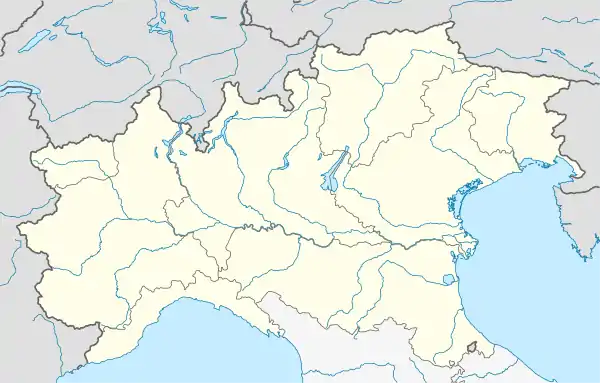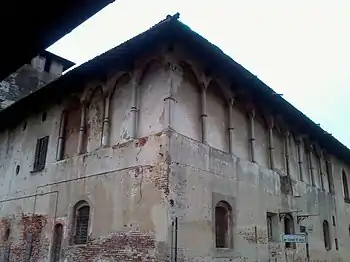Visconti Castle (Cusago)
The Visconti Castle or Castello Visconteo is a castle in the town of Cusago near Milan, Lombardy, Northern Italy. It was built in the 14th century by Bernabò Visconti and used as a hunting lodge by him and other members of his family. The castle underwent significant changes in the Renaissance period. Today it is in a state of neglect.
| Visconti Castle (Cusago) | |
|---|---|
Castello Visconteo di Cusago | |
| Cusago, Lombardy, Northern Italy | |
_-_BEIC_6330776.jpg.webp) The castle in a photo by Paolo Monti | |
 Visconti Castle (Cusago) | |
| Coordinates | 45°26′45″N 9°01′55″E |
| Type | Medieval castle, noble residence |
| Length | 96 m (315 ft) |
| Site information | |
| Owner | Private |
| Condition | Neglect |
| Site history | |
| Built | 14th–15th centuries |
| Built by | Bernabò Visconti, Ludovico il Moro |
History
Bernabò Visconti was lord of Milan between 1354 and 1385. He ordered the construction of the castle of Cusago in 1370. It had a quadrilateral plant, with a single tower over the entrance. It was created as a country residence and connected to a hunting park.[1] The most extended side measured 96 meters.[2]
The court of Bernabò Visconti frequently attended the castle. After the dethronement of Bernabò, the building passed to his nephew Gian Galeazzo, the first duke of Milan. Between 1425 and 1440, the Duke Filippo Maria Visconti took great care of the castle and the surrounding park. His mistress Agnese del Maino occasionally lived there. In 1438 a little canal (the naviglietto) was excavated to connect the castle to the nearby Naviglio Grande.[3]
After the Ambrosian Republic (1447-1450), the castle was abandoned, and part of the lands was sold. In 1496, Ludovico il Moro expanded the castle, restoring its function of a country villa for hunting and parties. A portico with eight arches was added to the entrance side towards the courtyard. A loggia was inserted in the north-eastern corner. The tower assumed the shape with the overlapping volumes, typical of the Sforza architecture, as it appears at the Castello Sforzesco in Milan.[1][4]
In 1496, Ludovico il Moro hosted in the castle the emperor Maximilian I.[2] Later, and until the 20th century, it was used as an agriculture warehouse and home for the farmers. The loggia was closed by a wall.[1]
Today
Ceased its agricultural use, the castle was abandoned. Today it is in a poor state of repair, awaiting restoration.
The castle stands as a backdrop to the Cusago central square. It is faced, on the opposite side, by the church of Saints Firmus and Rusticus.[1]

References
- Conti, Hybsch & Vincenti (1990), p. 54
- Del Tredici & Rossetti (2012), p. 45
- Del Tredici & Rossetti (2012), p. 44
- Del Tredici & Rossetti (2012), pp. 44–45
Sources
- Conti, Flavio; Hybsch, Vincenzo; Vincenti, Antonello (1990). I castelli della Lombardia. Provincie di Milano e Pavia (in Italian). Novara: Istituto Geografico de Agostini. ISBN 88-402-9108-3.
- Del Tredici, Federico; Rossetti, Edoardo (2012). Percorsi castellani: da Milano a Bellinzona: guida ai castelli del ducato (in Italian). Castelli del ducato. ISBN 9788896451021.
.svg.png.webp)